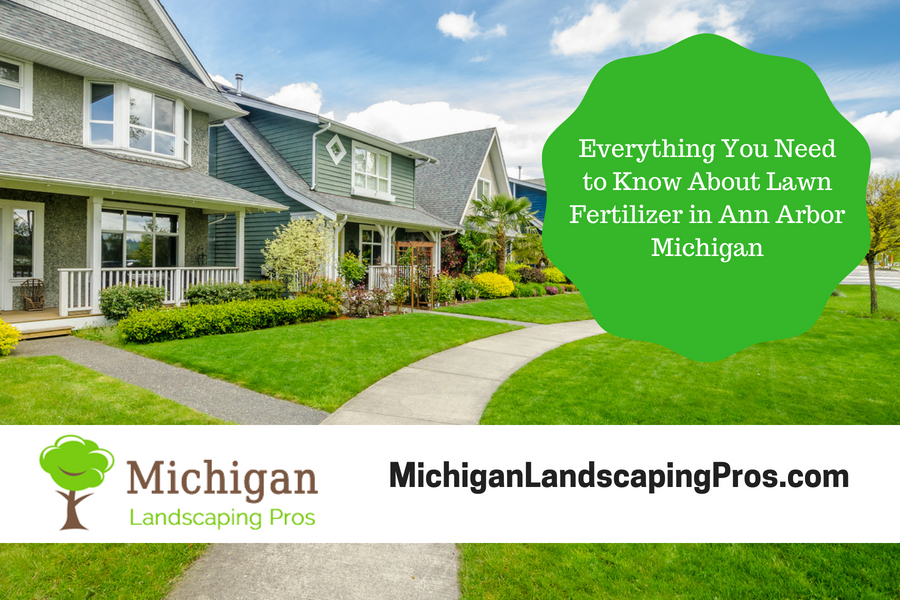Everything You Need to Know About Lawn Fertilizer in Ann Arbor Michigan
In order to have a healthy and prosperous landscape in Ann Arbor Michigan, your soil needs key nutrients. Since these key nutrients can be difficult to obtain by themselves, supplements known as fertilizers can be used. Purchasing a good lawn fertilizer can be difficult because there are various types of fertilizers. That being said, here is a quick guide of everything you need to know about lawn fertilizer.
Everything You Need to Know About Lawn Fertilizer in Ann Arbor Michigan
A well fertilized lawn is a healthy lawn that looks great. Not only can a great landscape make your home look great but it can also improve the value of your home by increasing the curb appeal of your home. Using fertilizer can help to give your lawn that look of a healthy lawn that looks amazing.

Gain Some Background Knowledge
Before we get into the different types of fertilizers, let’s break down the basics. Like previously stated, soil needs key nutrients. These primary nutrients are nitrogen (N), phosphorus (P), and potassium (K). These nutrients create the acronym NPK.
NPK becomes useful when you’re shopping for a lawn fertilizer. Fertilizers will show ratios like this 24:8:16 or 24-8-16. In both cases, the fertilizer would have a nitrogen ratio of 24%, phosphorus ratio of 8%, and potassium ratio of 16%.
NPK is also helpful because it can help you determine what fertilizer ratio is right for your soil. In order to find this ratio out, all you have to do is purchase a soil testing kit or hire a local landscaper in Ann Arbor Michigan to do it for you.
Organic vs Synthetic Fertilizers
Fertilizers either fall into the organic or synthetic category. Organic fertilizers are created from organic materials, such as plants, animals, and minerals. This makes organic fertilizers eco-friendly. Since organic fertilizers are made from natural substances, they often have lower concentrations of NPK and other necessary nutrients that a synthetic fertilizer would have.
On the other hand, synthetic fertilizers are chemically crafted from various nutrients. Like previously stated, synthetic fertilizers are able to have higher concentration levels of certain nutrients because they are chemically crafted. As for affordability, synthetic fertilizers are significantly cheaper than organic fertilizers.
Liquid Fertilizer
One of the most popular types of fertilizer in Ann Arbor Michigan is liquid fertilizer. Although liquid fertilizer has the term “liquid” in it, you might find one that comes in a powder concentration. Basically, liquid fertilizers require you to dilute them with water prior to use.
Once the fertilizer is diluted with water, you can use a hose or pot to apply it to your plants. Liquid fertilizers are most notable for their rapid release. In fact, you should see plant growth and improvement in only a few days. But, this also means that you are going to have to reapply the fertilizer more frequently. That being said, liquid fertilizer is a great option for smaller plants and areas around your home, such as houseplants.
Quick-Release Fertilizer
Quick-release fertilizers are basically small granules that need water in order to work. All you have to do is spread the fertilizer across the designated surface. Then, spray water on the fertilizer to release the chemicals and let it soak into the soil.
Although quick-release fertilizer provides quick results, you only have to reapply the fertilizer approximately once a month. This is because quick-release fertilizer often has a slow decomposition rate. Overall, quick-release fertilizer is a great option for any home landscape.
Slow-Release Fertilizer
Slow-release fertilizer is basically the opposite of quick-release fertilizer. Contrary to quick-release fertilizer, slow-release fertilizer simply soaks into soil after it’s placed on the top surface. Since this type of fertilizer has a slow-release quality, you don’t have to use water to instantly activate it. Instead, you can simply let the fertilizer sit and soak into the soil in a span of two to nine months.
The slow soaking rate of slow-release fertilizer is not only beneficial for you because you don’t have to worry about reapplying the fertilizer often and purchasing more fertilizer, but it is also extremely beneficial for your plants because it prevents burning from occurring. Since slow-release fertilizer doesn’t require a ton of reapplication, and can easily be spread out, it is a great option for homeowners who want to use fertilizer on a large area.
If you’re considering purchasing fertilizer for your houseplants and surrounding landscape, consider contacting Michigan Landscaping Pros for more information or a free consultation on your landscaping needs in Ann Arbor Michigan.
